Abstract
In article it is showed the definition technological parameters
of one chamber two saw cylinder gin. For maintenance of efficiency of
ginning and productivity increase it is necessary to choose correctly
diameter of the working chamber, an arrangement corner saw cylinders
under the relation of a horizontal axis. These factors are major factors
influencing productivity and quality of a fiber at practical and
theoretical researches of one chamber two saw cylinder gin.
Keywords: Regression Model; Optimization of Parameter; Angular Position; Saw Cylinder
Introduction
The choice of the necessary technological parameters is the main
responsible stage in the design of cotton gin with new working bodies.
In the process of fiber separation from the seed, the increase in
productivity and the effective elimination of seed damage depend on the
selected input parameters. The use of mathematical methods in planning
practical experimental work in comparison with other methods of
calculation, optimization parameters allows determining the influence of
several factors acting together and their interaction among themselves
in terms of separation. As a result, based on the few experiments that
have been carried out, it is possible to obtain a mathematical model of
the object under study; this model will allow obtaining optimal
solutions at the time. In optimization, the main issue is this
determination of the important factors affecting the process of hair
removal of cotton fiber from seed this will serve for efficient fiber
separation in the process of ginning [1-3]. The following parameters we
chose for optimization:

Using the results of the theoretical study including the literary
survey of gins and also taking into account the primary one-factor
experiment, the choice of the output parameters affecting the incoming
factors was chosen as follows.

Feed rolls 1 feeding the pin drum 2, a bracket and a clamping bar 3, a
brush drum 4, a shaft of the brush drum 5, a saw cylinder 6, an upper
grate 7, a gin working chamber 8, a lower grate 9, a cement cylinder 10,
a screw 11, knife-like mesh surface 12 (Table 1) and (Figure 1).
Table 1: Factor name and numbering.
 Figure 1:
Figure 1: New Gin Machine.
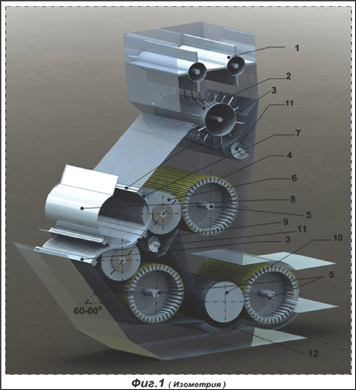
The theoretical studies, it was justified to create a new design for
two-cylinder gin. The main working body of the new design is an
additional saw cylinder, which allows uniform rotation of the raw roller
of productivity. To ensure the efficiency of fiber separation and
increase productivity, it's necessary to choose the diameter of the
working chamber correctly, the angle of the sawing cylinders in relation
to the horizontal axis. These factors are the main factors effecting
the productivity and quality of fiber in practical and theoretical
studies. The process of ginning associated with many factors is
investigated by modern mathematical methods of planning and is
calculated by modern computer programs with the help of a computer
[4-6]. These methods allow you to get the optimal solution with the
least cost. On the basis of the indicators of natural factors, we turn
to the coded indicators. The full-factorial test results showed that the
investigated process is expressed by the high-level equation. Because
of this, to obtain a regression mathematical model of the second degree,
this model is considered to be simple and convenient in comparison with
other methods, and also in the primary cotton processing enterprises, a
non-method method is widely used in technological processes. It was
chosen and used in the conducted experiment. The results of the central
non composite experimental matrix are given in Table 2.
Table 2: Central non-composite experimental matrix.
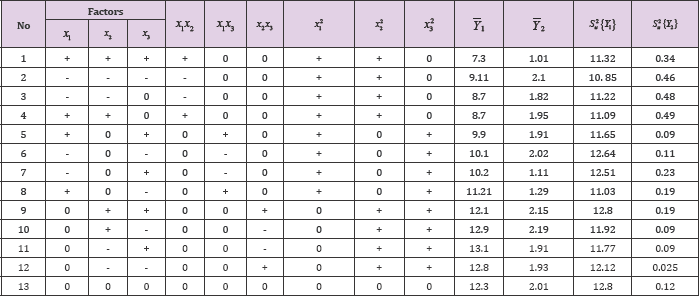
For each experiment it is necessary to use instruments with high
accuracy of measurement. In our studies, to change the dimensions of the
working chamber, we used already prepared working chambers of different
diameters.The fiber performance we determined by the existing method
and formula. When using a new working chamber, 100 kg of raw cotton was
shipped from the feeder hopper. Each variant of the experiment was
conducted five times. In the course of the experiment, the angular
arrangement of the saw cylinders with respect to the horizontal axis
exerted a great influence on the productivity. The design of the working
chamber was made with a high level of measurement. The experiments were
conducted according to the principle of randomization. After each
experiment (at a certain time), the fiber yield level is determined.
After the experiment, the samples were tested according to standard
requirements in special laboratories for fiber and mechanical damage to
the seeds. Based on the results obtained during the experiment, we use a
multifactorial regression mathematical model of the second degree.
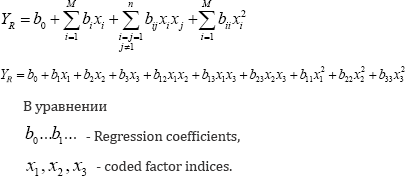
I. Calculation of the productivity of the fiber. Define the coefficients of regression:
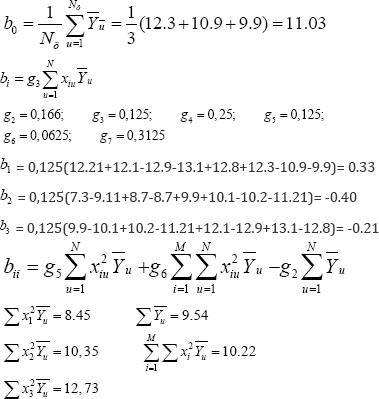

Write the equation according to a certain regression coefficient:

Let.com determine the regression coefficient by acceptability.
To do this, we define the variance of the output parameters

And based on the determination of the regression coefficient, we calculate the variance:
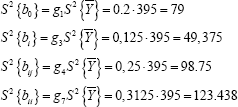
When determining the regression coefficient, we determine the standard deviation:

After this, using the following equation, we determine the indications by the Student's criteria:

It is known that if the calculated criterion data are lower than
those given in the data table, then the coefficient is not important and
we derive the data from equation It was found that for the parameters
under study, the coefficients of the experiments are not important and
necessary:
Let.com re-write the equations with significant coefficients:

To determine the above regression mathematical model for adequacy and inadequacy, we use the test data of the Fisher criteria.
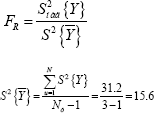
Here,

For the results of the output parameters, we use the three factorial two-power regression mathematical model of the equation:

An analysis was made of the data obtained from the three factor
mathematical regression model taking into account the necessary
regression coefficients by the Student's criterion and also the results
of the models tested for Fisher's adequacy.
After In order to simplify the calculations, we create a Table 3:
 Table 3:
Table 3: Indicators of the Student's test can be taken from the application:
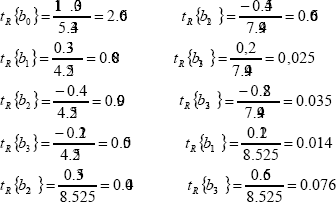
It is known that if the data of the calculation criteria is lower in
comparison with the data given in the table, then this coefficient is
adequate and this makes the calculations correct.

From this it follows that the regression mathematical model obtained
fully characterizes the process of investigation (Table 4) and (Figure
2).
Table 4: Regression model

Conclusion
Comparison of the obtained data by the experimental method and the
obtained regression mathematical model fully characterizes the process
of research with accuracy. Thus, the optimal technological parameters of
the single-chamber doublecylinder gin were determined. It can be seen
from Figure 2 that when the saw cylinders are positioned at 450-600
degrees relative to the horizontal axis with a working chamber diameter
of 180 mm, it makes it possible to increase the productivity by
synchronizing the fiber quality. From this it follows that when
designing a two-cylinder gin, it is necessary to comply with optimal
regime for improving fiber quality and productivity.
Figure 2: Graph of the regression model.
Blue line-diameter of chamber;
Red line-saw cylinders positioned at 450-600 degrees
relative to the horizontal axis;
Green line-capacity of fiber kg/hour.
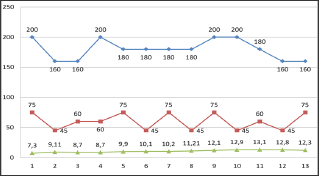






















No comments:
Post a Comment
Note: only a member of this blog may post a comment.